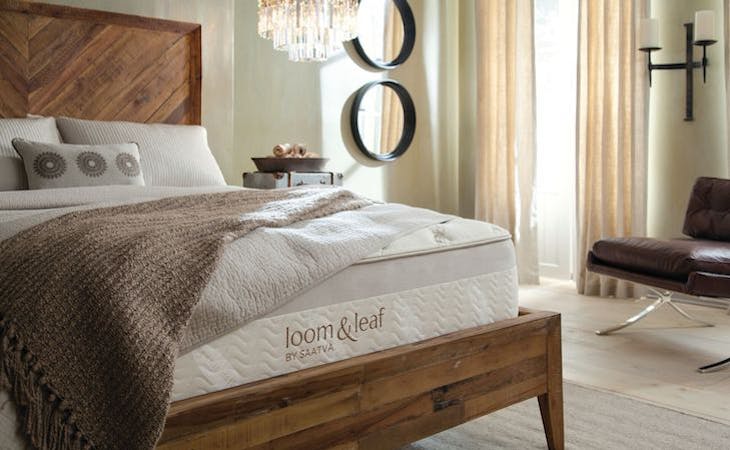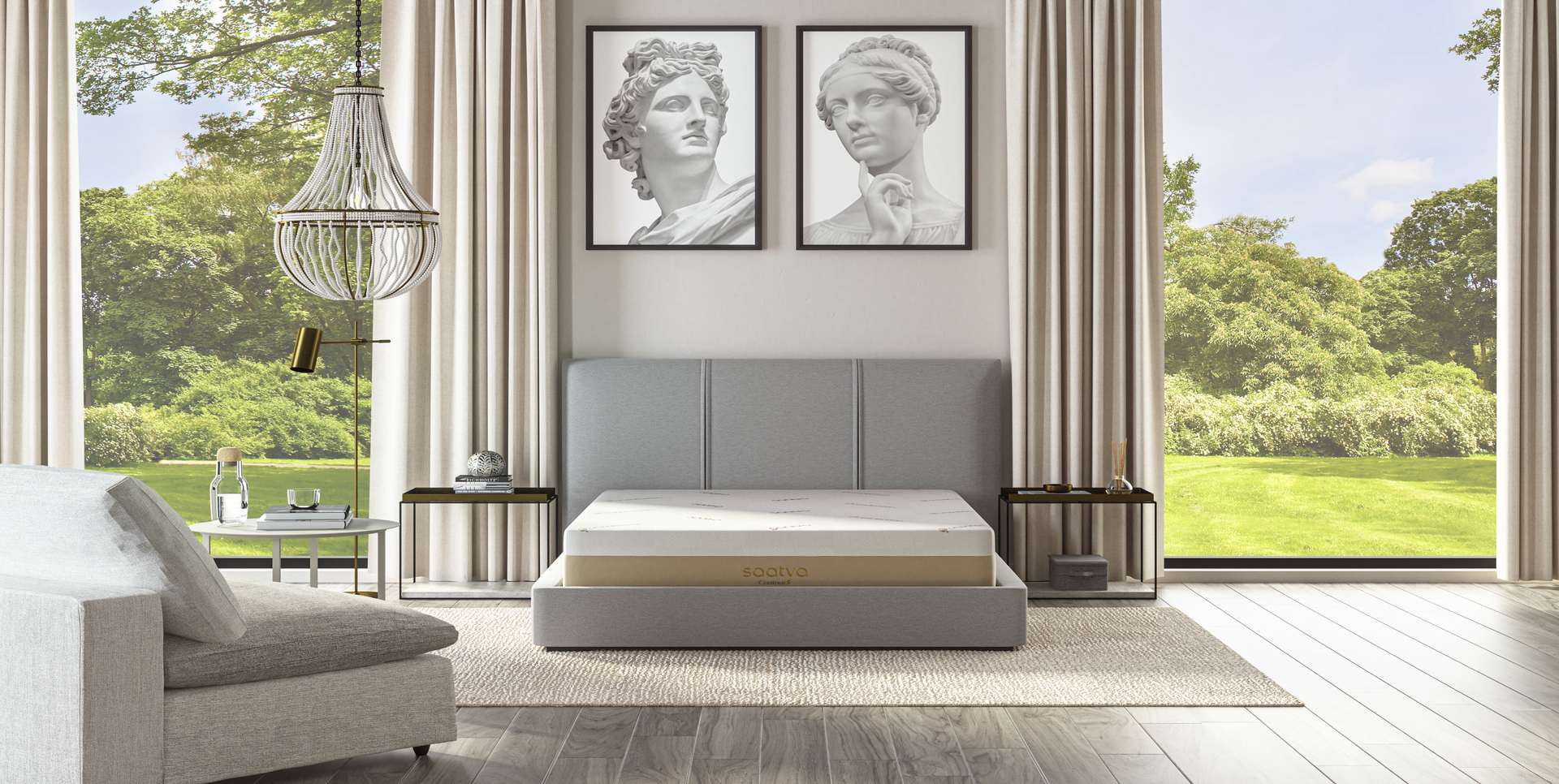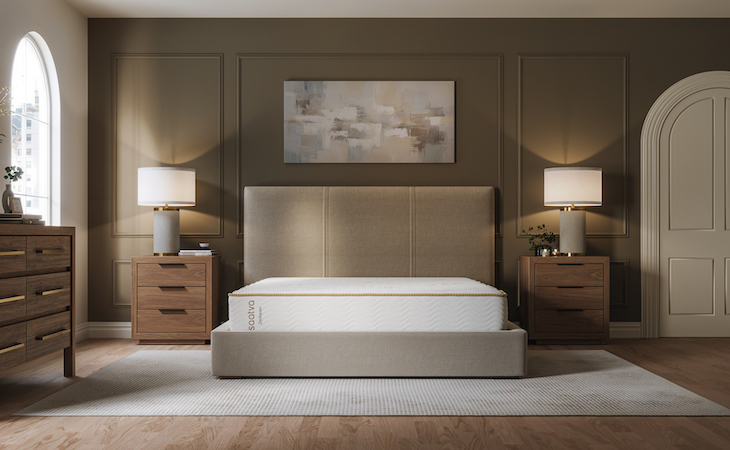Astronauts not only landed on the moon—they’re also (indirectly) responsible for changing the way Americans sleep. In the 1960s, NASA commissioned researchers to develop seating foam that would keep test pilots better cushioned during flights.
They came up with memory foam (originally called “slow springback foam”), and the rest is history. The material is now used in everything from mattresses to movie theater seats to football helmets.
If you’re considering a new memory foam mattress, here’s everything you need to know, from what’s between the covers to how to assess quality to which type of sleepers memory foam suits best.
What is a memory foam mattress?
A
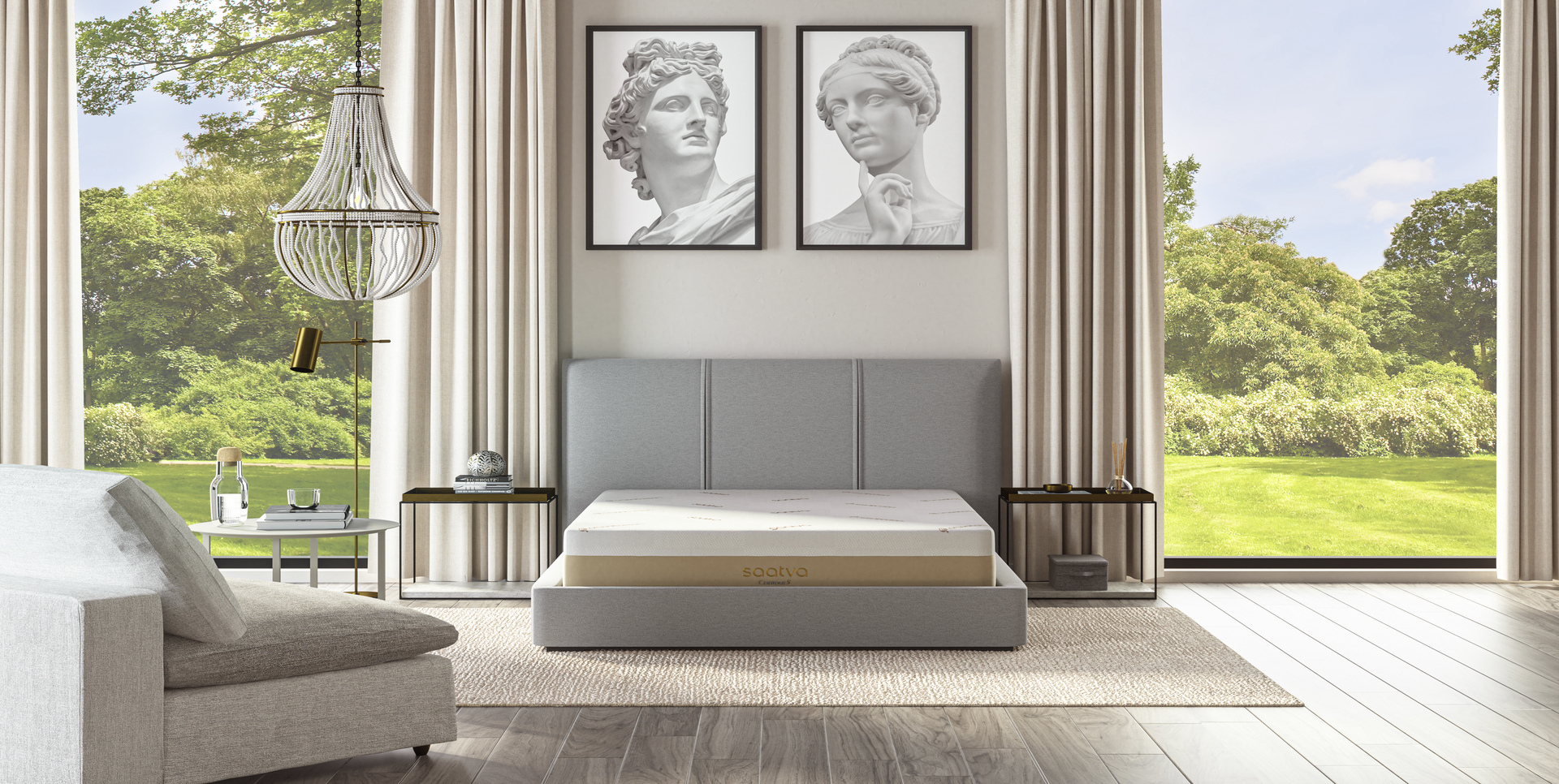
The most luxurious memory foam with adaptive cooling & body-hugging support
is one made from viscoelastic foam, a type of high-density polyurethane foam. (Greener versions of memory foam use plant-based ingredients like soybean oil in place of some of the petroleum derivatives.)
Memory foam’s distinguishing feature is that it softens in response to heat and pressure. That’s what gives it the body-hugging feel many sleepers love.
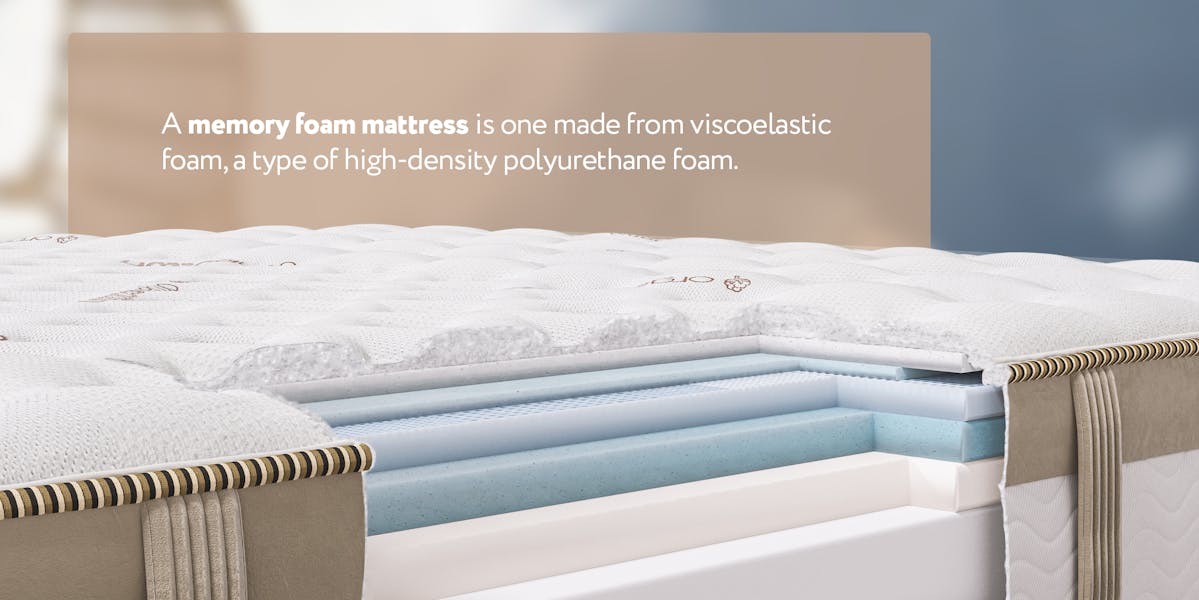
Most memory foam mattresses aren’t made solely from memory foam, though. If they were, they’d be so soft that you’d sink too deeply into the bed. Instead, premium memory foam mattresses feature layers of foams in varying thicknesses and densities for the optimal balance of comfort and support.
What’s inside of a memory foam mattress?
There are a handful of components common to most memory foam mattresses. The parts of a memory foam mattress are:
- Support core (bottom layer)
- Transition foam (middle layer)
- Comfort layer (top layer)
The bottom layer is the support core, which is often made from polyurethane foam and is strong enough to support the body’s weight. From there, you’ll likely find a layer of transition foam, followed by a top comfort layer (or multiple layers) of memory foam. When comparing memory foam mattresses, these are the key things to look for:
Foam density
While it’s not an exact science, the rule of thumb is that the higher the foam density the higher the quality and the heavier the mattress. (Memory foam mattresses often weigh upwards of 100 pounds.)
Higher-density foam translates into a more durable mattress that should last you anywhere from 10 to 15 years. Look for foam density of at least 3 pounds per cubic foot. Premium memory foam has a density of 4 to 5 pounds per cubic foot.
Keep in mind that you may have to go digging for this info, though, as it’s often not front and center. By looking through the brand’s website or speaking to their customer service team, you should be able to find this information most of the time.
If you’re shopping for a memory foam mattress, no doubt you’ve come across the trend of beds in a box. Many of today’s popular memory foam mattresses are first compressed down to one inch, vacuum sealed, rolled, and placed into a box before shipping. They are then sent via UPS or FedEx to your doorstep.
While beds in a box are cost-effective and convenient, they’re typically made with lower memory foam density so they can be squeezed into a box. The bed in a box trend may not be for you if you’re looking for a long-lasting mattress that offers extra support.
Firmness
Memory foam firmness is measured in “indentation load deflection,” or ILD. In layman’s terms, that’s how much pressure it takes to make a 25% indent in a 4-inch piece of foam. Quality memory foam has an ILD between 10 and 50. (The higher the ILD, the firmer the mattress.) Again, check the brand’s website or reach out to customer support for the ILD if the info isn’t readily available.
ILD can be useful as a point of comparison, but keep in mind that comfort is subjective. Whether you prefer a memory foam mattress with a lower or higher ILD will depend on whether you like a softer or firmer sleep surface. (Read our guide to finding the right comfort level for you.)
Different types of memory foam
Within the memory foam mattress category, there are a few varieties. The most common types of memory foam on the market include:
- Traditional memory foam
- Gel-infused memory foam
- Eco-friendly memory foam
Each of the different types of memory foam mattresses has its own individual benefits. Here’s an overview of the major benefits of each type of memory foam:
Traditional memory foam
Also known as viscoelastic foam, traditional memory foam is made from polyurethane, a petroleum derivative. Because of that, it can sometimes give off a chemical smell—a process referred to as off-gassing. That’s the term for what happens when volatile organic compounds (VOCs) leak out of mattress foams into the air you breathe.
Common VOCs include formaldehyde, toluene, chlorofluorocarbons (CFCs), benzene, trichloroethane, and perfluorocarbons. Although there’s no evidence that off-gassing can have permanent effects on your health, it does contribute to indoor air pollution and is potentially irritating to people with chemical sensitivities or breathing issues. (Learn more about off-gassing here.)
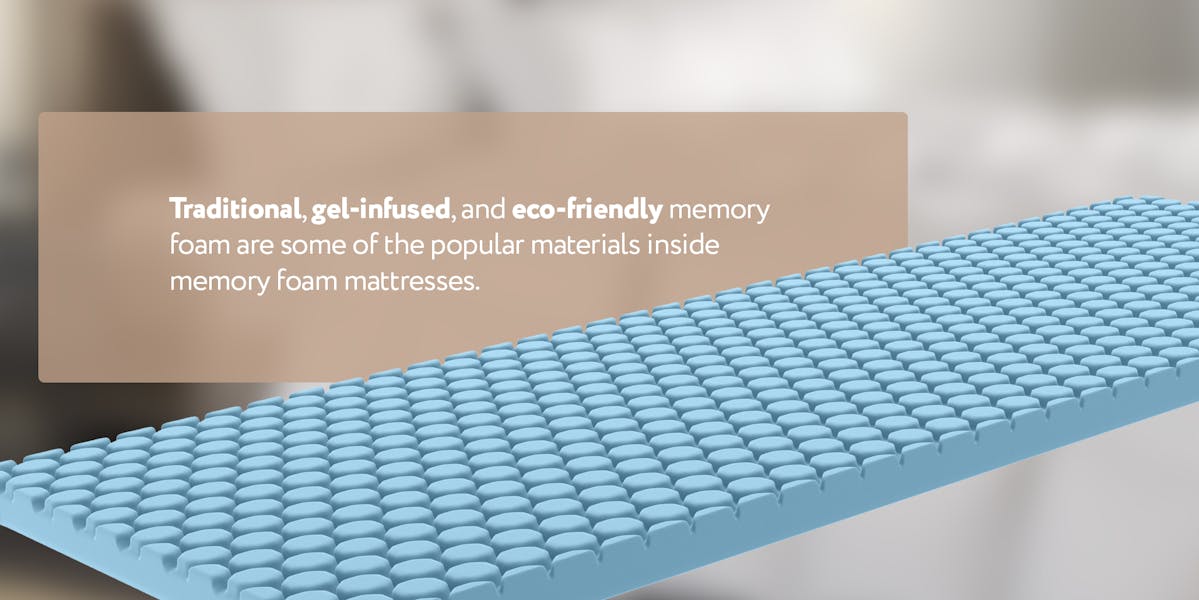
Gel-infused memory foam
Newer types of memory foam often contain materials that help keep you cool while you sleep, since one of the biggest complaints about memory foam is that it sleeps hot. These materials are designed to absorb and conduct heat away from the body.
The top layer of foam normally contains some form of cooling properties, whether gel, graphite, or copper. Cooling gel can either be mixed into the foam (infused) or applied as a layer on the surface (laminated).
Eco-friendly memory foam
“Greener” memory foam uses plant-based ingredients, such as soybean and corn oil, in place of some of the petroleum derivatives. To find a healthier memory foam mattress, look for one that has certified low-VOC foams. One such certification is CertiPUR®1.
Foams that carry this label are free of CFCs, formaldehyde, phthalates, and polybrominated diphenyl ethers (PBDEs, a class of chemical flame retardants banned in the United States since 2005). As an added bonus, eco-friendly foams feature a more open-celled structure, so they are more breathable, allowing you to sleep cooler.
Sleep positions and memory foam mattresses
One of the reasons memory foam continues to grow in popularity is that this type of bed supports a wide range of sleep styles. Within the memory foam category, look for these features depending on your preferred sleep position:
Side sleepers
Side sleepers benefit from snoozing on a softer memory foam mattress that keeps their spine in alignment while cushioning shoulders and hips. Look for added support in the lumbar region to protect the heaviest part of your body.
Back sleepers
Anything too soft will cause you to sink into the bed, while anything too firm will put too much pressure on your shoulders and back, causing soreness when you wake up. If you’re a back sleeper of average weight, look for a medium-firm memory foam mattress.
Stomach sleepers
Because memory foam molds to the shape of your body, you may not like the feel of it if you sleep on your stomach. If you’re still interested in memory foam, look for one that’s firm enough to give you the support you need. Anything from a medium-firm to a firmer mattress is what you’ll want.
The biggest benefits to a memory foam mattress
There are several reasons why you might want to choose a memory foam mattress over another type of bed. These benefits include:
- Joint pain relief
- Additional spinal support
- Limited motion transfer
- Allergy symptom reduction
- Durability
Let’s take a deeper look into these benefits and see exactly how a memory foam mattress can create a better sleeping experience for both single adults and couples.
Joint pain relief
People with joint pain will appreciate the conforming ability of a memory foam mattress, as it gives the feeling of hugging the pressure points of the body. (Here are more tips for sleeping better with chronic pain.)
Additional spinal support
Memory foam conforms to your body, helping to keep your spine in neutral alignment. This ensures you won’t wake up with a sore lower back. The pressure relief will, in turn, help create a better sleeping experience.
The pressure-relieving qualities of memory foam can help support your spine and reduce your back pain no matter what position you tend to sleep in.
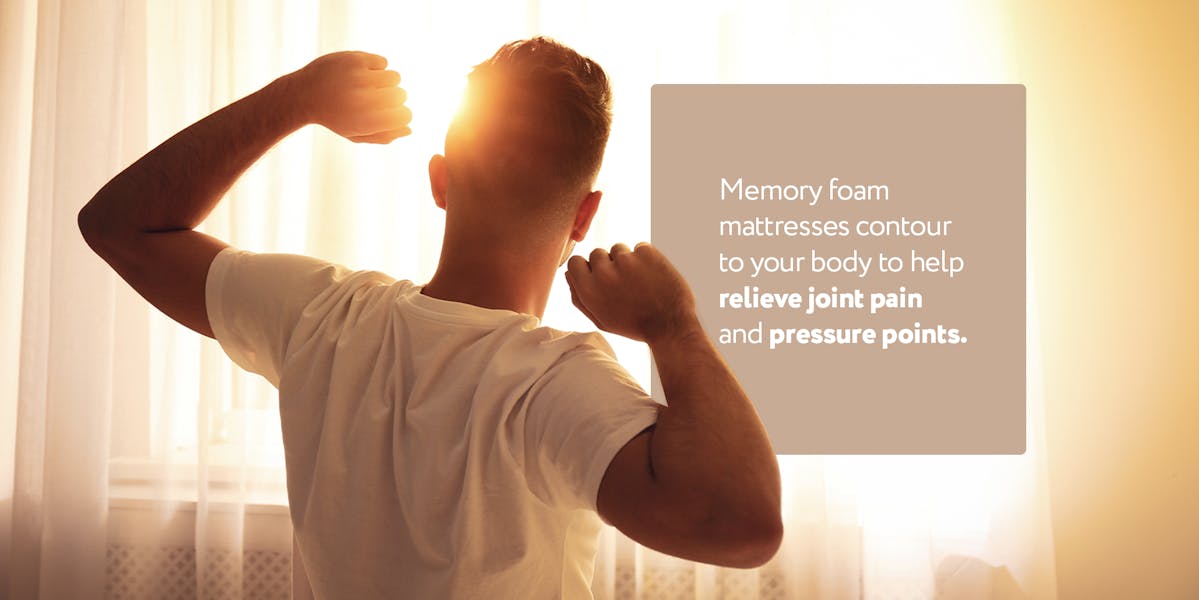
Limited motion transfer
With a memory foam mattress, you won’t have to worry about being woken up by a partner in the middle of the night if they get out of bed. Because the mattress isn’t tied together in one consecutive coil system, if your partner gets up to use the restroom in the middle of the night, you aren’t going to feel anything.
The motion isolation properties of memory foam mattresses can help couples sleep better together, especially if they have different sleeping habits.
Allergy symptom reduction
Unlike innerspring mattresses, memory foam mattresses don’t have a lot of nooks and crannies that dust mites can live in, meaning they can be a better option if you suffer from allergies. Sleeping on a memory foam mattress if you have allergies can really help improve your sleep experience.
Durability
A well-made memory foam mattress should last 10 to 15 years if it’s properly taken care of. Softer mattresses tend to need replacement more often, but a high-quality memory foam mattress can last more than a decade. Additionally, some mattresses may come with a lifetime warranty to make your initial purchase even more beneficial.
Memory foam mattress drawbacks
There are pros and cons to every type of mattress, including memory foam. If you’re in the market for a new mattress, memory foam might not be right for you. See the biggest drawbacks to a memory foam mattress below:
Not much temperature control
By design, memory foam responds to temperature, softening as it warms and molding to your curves. While that contouring ability is one of its most beloved features, memory foam can trap and retain heat close to your body, so you might want to consider another option if you sleep hot.
An open-cell polyfoam mattress could be the right choice in this situation. Open-cell foam mattresses are great for hot sleepers and still offer a low-density comfort level to help reduce body heat.
There are also gel memory foam mattresses on the market that tend to regulate body temperature much better than a traditional memory foam mattress. Their firmness level is similar to a traditional memory foam bed, but the gel support layer helps keep you cool while you sleep and reduces the chances of overheating.
Not great for bigger body types
A memory foam mattress is better suited for sleepers under 200 pounds. Anything higher and there is the potential for the sleeper to “bottom out” on the mattress and not receive the necessary support.
If you have a higher body weight or a bigger body type, it may be best for you to consider a firm mattress, like an innerspring, or a medium-firm mattress, like a hybrid mattress.
Not very bouncy
Innerspring mattresses are known for their responsiveness, but that’s not the case for memory foam. If you like the springy feel of a traditional mattress, you may not like the feel of memory foam. Keep in mind that that bouncy feeling is something many couples look for when it comes to sex.
Finding a trustworthy memory foam mattress brand
Not all mattress brands are created equal. And not all memory foam mattresses are of the same level of quality. Purchasing your next memory foam mattress from a trustworthy mattress brand is incredibly important.
You want to make sure you’re getting a high-quality mattress made of high-density memory foam. High-quality, high-density memory foam will be comfortable to sleep on and will also last you for years to come.
When mattress shopping, there are a few things to look at to ensure you’re buying from a trustworthy brand. These include mattress certifications, customer reviews, manufacturing processes, warranties, and even sleep trials.
Mattress certifications
There are a few third-party companies that offer mattress certifications. These certifications most likely mean that a brand uses high-quality materials and has a high safety rating. Here’s a list of popular mattress certifications and what they mean:
- CertiPUR-US®: CertiPUR-US®-certified foams are guaranteed to be low in VOCs, which can cause off-gassing. This type of certification also guarantees that mattress materials are free of ozone depleters; PBDEs, TDCPP, and TCEP flame retardants; mercury, lead, and other heavy metals; formaldehyde; and phthalates.
- OEKO-TEX: The OEKO-TEX Standard 100 is an internationally recognized standard for certifying textiles and home furnishings. Mattress materials that carry the OEKO-TEX Standard 100 seal are tested and found to be free of toxic chemicals.
- GreenGuard: If your next memory foam mattress has the GreenGuard Gold certification, that means it’s met stringent emissions standards and has lower levels of VOC emissions.
- Global Organic Textile Standard (GOTS): If a mattress material bears the GOTS symbol, that means it’s made with at least 95% organic fibers.
- Global Organic Latex Standard (GOLS): Latex foam with the Global Organic Latex Standard (GOLS) symbol must contain more than 95% certified raw organic material and adhere to GOLS limits on harmful chemicals, fillers, and emissions. Latex is tracked from harvest to final product to ensure proper manufacturing sustainability.
- Cradle to Cradle: Mattress materials with the Cradle to Cradle Certified seal meet all the standards in these five sustainability categories: material health, material reuse, renewable energy and carbon management, water stewardship, and social fairness.
Customer reviews
Whether you’re shopping for a nifty keychain or a memory foam mattress, customer reviews are a goldmine of helpful information.
Reading trustworthy reviews from verified customers can help you determine the quality and comfort of the product. Think of it this way: You can use customer reviews to get an idea of the feel, firmness, and comfort level of a memory foam mattress before buying.
Manufacturing process
It’s essential to be mindful of the manufacturing process mattress companies use when making their products so you can be sure you’re getting a quality mattress.
It’s best to buy a mattress from a company that manufactures its products in the USA. While there’s nothing inherently superior about American manufacturing, it does give companies a better chance of managing production and offering high-quality products. It allows for quality control standards, has a positive environmental impact, makes for easy delivery to customers, ensures high safety standards are met, and supports the local economy.
Sleep trials and warranties
It can be hard to figure out if a mattress is right for you when you only have five minutes to try it in a store or if you’re buying one online. Sleep trials are key, as they allow you to try the mattress in your home for a few months before deciding if the mattress is right for you. The good news is, most mattress brands offer a sleep trial period. This can range anywhere from a few months up to a year, depending on the brand.
It’s also a good idea to look for a mattress that comes with a warranty. Most mattresses come with a 10-year warranty, while some come with a 20-year warranty or even a lifetime warranty. Just make sure to read the fine print so you know what’s covered—and not covered—by the warranty.
Getting a supportive bed base for a memory foam mattress
Speaking of support, your mattress needs it too. A memory foam mattress is usually paired with a
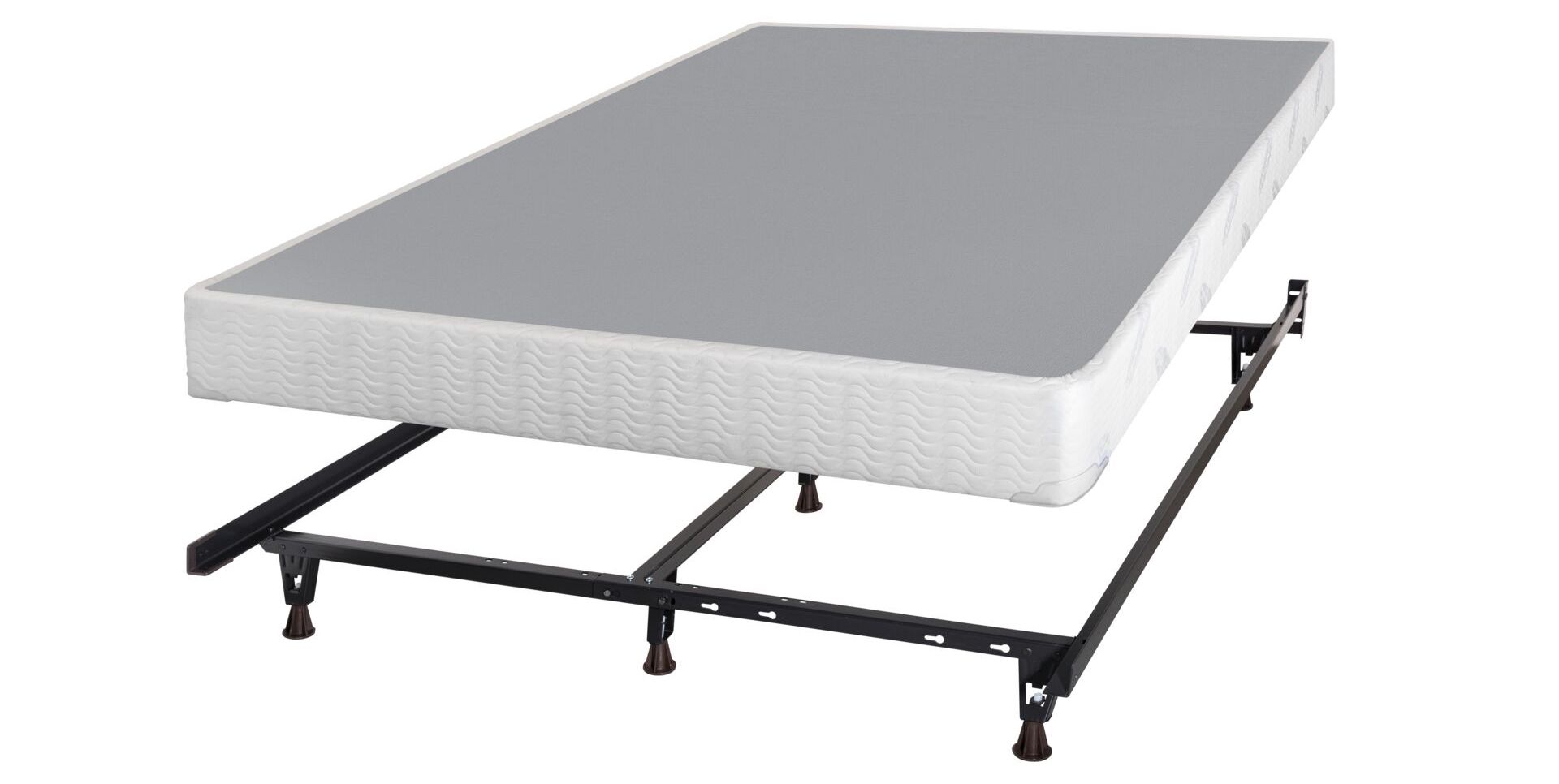
Better than a box spring, our foundation adds optimal support & durability
(aka box spring) or base. These are often lower cost than some of the other options on the market, and they can be very supportive for a memory foam mattress. These mattresses can also be paired with an
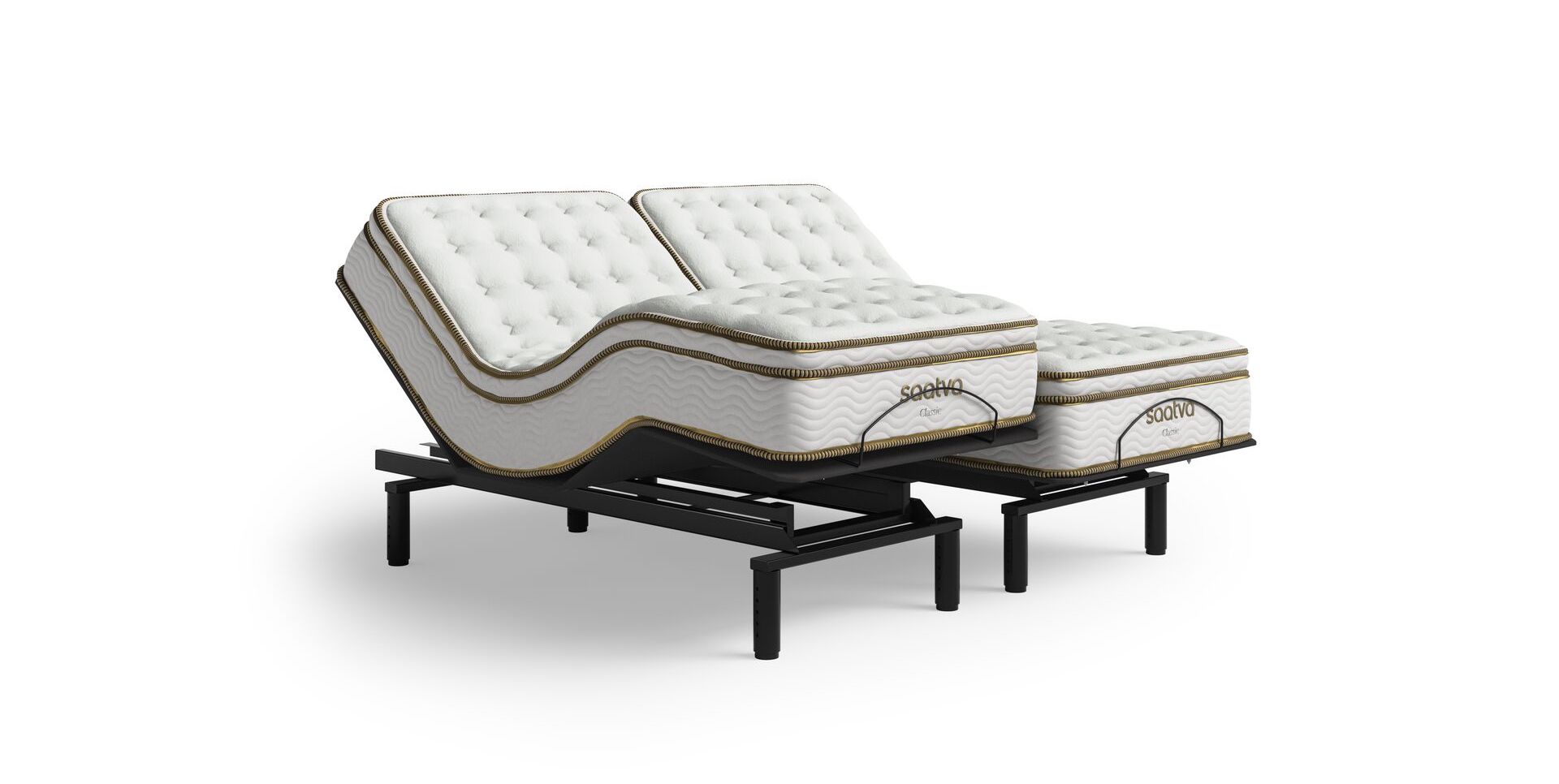
Our deluxe adjustable base with even more customized comfort options
.
An adjustable base can help you get into an ideal sleep position. By allowing you to elevate your head, an adjustable base can also help with snoring and acid reflux.
Adjustable bases work best with soft mattresses, like memory foam, because of how flexible they are. Using a memory foam mattress with an adjustable base will give your mattress a longer lifetime compared to using an innerspring mattress with this kind of setup.
Memory foam mattress FAQs
The myriad of choices surrounding memory foam can be dizzying. No worries! We’re here to put your mind at ease and answer your most frequently asked questions about memory foam mattresses.
What is the best thickness for memory foam mattresses?
The mattress industry produces a wide range of mattress heights, or thicknesses, to fit just about any preference. The standard mattress height is 8 to 12 inches thick. However, these days, it’s common to find 14-, 16-, and 18-inch mattresses. Keep in mind that mattress thickness alone isn’t an indicator of quality.
The memory foam mattress thickness that’s best for you depends on a variety of factors. For example, if you want to get in and out of bed with ease, then a thicker mattress might be the ideal choice for you since it will require less exertion. But if you have mobility issues or are shorter in height, then you may want to consider a less thick mattress.
Are memory foam mattresses difficult to clean?
Memory foam mattresses can be difficult to clean, but it really depends on the kind of stain. The number one rule when it comes to cleaning memory foam mattresses is to avoid getting them too wet. It will take forever for this mattress type to dry out, which increases the possibility of mold and mildew buildup.
The best cleaning solution for a memory foam mattress stain is a combination of 3/4 cup warm water, 1/4 cup vinegar, and a tablespoon of liquid dish soap in a spray bottle. This powerful combo can treat just about any mattress stain.
After applying sparingly to the stain, allow the solution to sit for a few minutes (depending on the type of stain), then blot with a paper towel or dry cloth, and let the mattress air dry. Once completely dry, sprinkle with a bit of baking soda to absorb any lingering odors.
What is the difference between memory foam and latex foam?
Both memory foam and latex foam are good mattress materials, but they do have a few key differences.
Memory foam, also known as viscoelastic foam, is a type of high-density polyurethane foam. It softens in response to heat and pressure, which gives it a body-hugging feel. Memory foam is known for contouring to your body’s curves, which also makes it great for reducing “motion transfer” from one side of the bed to the other, so your movements won’t disturb your partner. Traditional memory foam tends to trap heat and sleep hot, but newer models usually have cooling gel or other ventilation features so they don’t trap as much heat.
Latex foam, on the other hand, is a natural material made from the sap of the rubber tree. Because it’s derived from natural sources, it’s biodegradable, hypoallergenic, and generally more eco-friendly. Latex foam has a somewhat similar contouring feeling to memory foam, but latex pushes back more against your weight, giving a greater sense of buoyancy. Latex sleeps cool, thanks to its open-cell structure, which promotes better airflow.
What kind of bed frame should I use with a memory foam mattress?
Memory foam mattresses will typically work with just about any bed frame. However, you should always check with the manufacturer and read the fine print first before deciding on a bed frame.
The most popular option is the metal bed frame because it’s the most budget-friendly option. The mattress sits on top of a standard wood foundation which, in turn, sits inside of a metal frame. Platform beds are another popular option. They have a clean and modern look and can be used without a foundation. Platform beds typically sit closer to the ground.
How long do memory foam mattresses last?
It varies depending on product quality. A high-quality memory foam mattress could last you up to 10 years or more if it’s made with high-density foam of at least 3 pounds per cubic foot. On the other hand, bed in a box foam mattresses that are made with low-density foam may only last you a handful of years.
Where to buy the best memory foam mattresses
If you’ve made it this far, we know you’re serious about your memory foam mattress purchase. Saatva makes high-quality and super-comfortable memory foam mattresses in almost every size. Plus, we offer a 365-night sleep trial with every mattress purchase, so you have plenty of time to decide if a Saatva memory foam mattress is a match for you.
You can find our top picks for Saatva’s best memory foam mattresses and take our mattress quiz today to determine which one is right for you.
- CertiPUR-US® is a registered trademark of the Alliance for Flexible Polyurethane Foam, Inc. ↩︎

